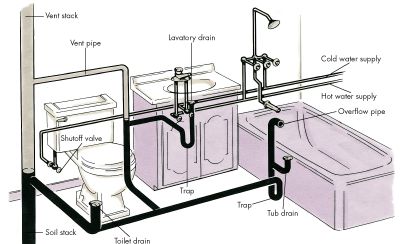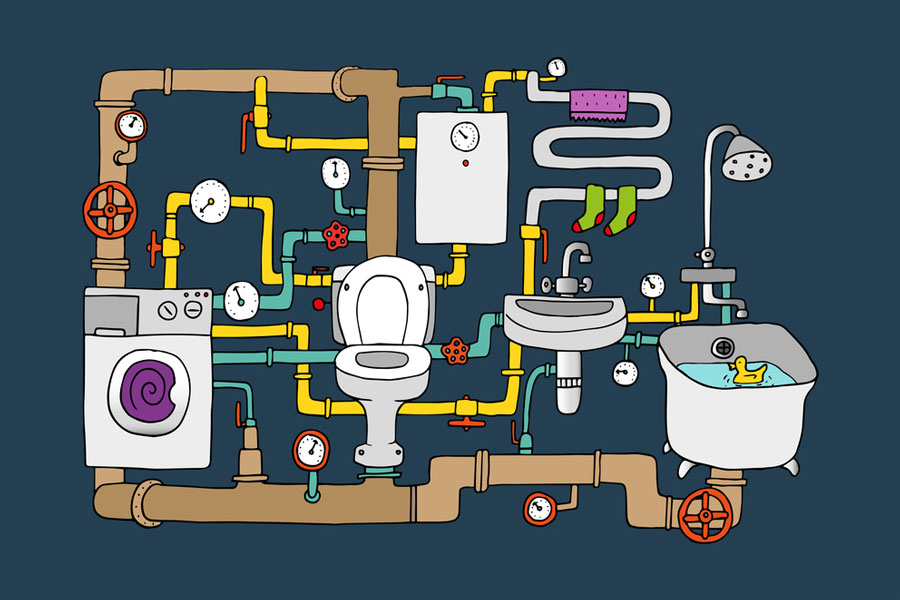We've stumbled upon this great article about Anatomy of a House: Understanding the Components below on the internet and decided it made sense to talk about it with you on my blog.

Recognizing just how your home's plumbing system works is vital for each house owner. From providing clean water for alcohol consumption, food preparation, and showering to securely getting rid of wastewater, a well-maintained plumbing system is critical for your household's health and wellness and comfort. In this thorough overview, we'll check out the complex network that composes your home's pipes and offer ideas on maintenance, upgrades, and handling usual concerns.
Intro
Your home's plumbing system is more than just a network of pipes; it's a complex system that ensures you have accessibility to tidy water and effective wastewater removal. Knowing its parts and exactly how they collaborate can help you prevent expensive repairs and ensure every little thing runs efficiently.
Fundamental Components of a Pipes System
Pipelines and Tubing
At the heart of your plumbing system are the pipelines and tubes that bring water throughout your home. These can be made from various products such as copper, PVC, or PEX, each with its advantages in terms of longevity and cost-effectiveness.
Fixtures: Sinks, Toilets, Showers, and so on.
Fixtures like sinks, commodes, showers, and bathtubs are where water is made use of in your house. Comprehending exactly how these fixtures attach to the plumbing system aids in identifying problems and intending upgrades.
Shutoffs and Shut-off Factors
Shutoffs manage the circulation of water in your pipes system. Shut-off valves are critical during emergency situations or when you require to make repairs, allowing you to separate parts of the system without disrupting water circulation to the whole home.
Water Supply System
Key Water Line
The primary water line attaches your home to the local water supply or a personal well. It's where water enters your home and is distributed to different fixtures.
Water Meter and Stress Regulator
The water meter procedures your water usage, while a stress regulatory authority ensures that water flows at a secure pressure throughout your home's pipes system, preventing damage to pipes and components.
Cold Water vs. Warm water Lines
Comprehending the difference between cold water lines, which provide water directly from the primary, and warm water lines, which lug warmed water from the hot water heater, helps in repairing and planning for upgrades.
Drain System
Drain Pipes Pipes and Traps
Drain pipelines carry wastewater far from sinks, showers, and toilets to the drain or septic system. Traps avoid sewage system gases from entering your home and also trap debris that can create clogs.
Ventilation Pipelines
Air flow pipelines allow air into the drain system, avoiding suction that can slow drainage and trigger catches to empty. Appropriate air flow is crucial for keeping the honesty of your plumbing system.
Significance of Appropriate Water Drainage
Making certain proper drain stops backups and water damages. Consistently cleaning drains and preserving catches can protect against expensive fixings and extend the life of your plumbing system.
Water Furnace
Types of Water Heaters
Hot water heater can be tankless or traditional tank-style. Tankless heating units warmth water on demand, while storage tanks store heated water for instant use.
Upgrading Your Pipes System
Factors for Updating
Updating to water-efficient fixtures or replacing old pipes can improve water quality, decrease water bills, and enhance the value of your home.
Modern Plumbing Technologies and Their Benefits
Check out technologies like smart leak detectors, water-saving toilets, and energy-efficient water heaters that can save money and reduce ecological influence.
Price Considerations and ROI
Calculate the ahead of time prices versus long-lasting savings when considering plumbing upgrades. Many upgrades spend for themselves with reduced energy costs and less repair services.
Exactly How Water Heaters Attach to the Pipes System
Comprehending just how hot water heater link to both the cold water supply and hot water distribution lines helps in detecting concerns like inadequate warm water or leakages.
Maintenance Tips for Water Heaters
Routinely flushing your hot water heater to eliminate debris, inspecting the temperature settings, and evaluating for leakages can prolong its lifespan and boost energy efficiency.
Common Pipes Issues
Leakages and Their Reasons
Leaks can occur as a result of maturing pipes, loose fittings, or high water stress. Attending to leakages quickly protects against water damage and mold and mildew development.
Clogs and Clogs
Blockages in drains pipes and bathrooms are often brought on by flushing non-flushable items or a build-up of grease and hair. Making use of drain displays and bearing in mind what goes down your drains pipes can stop clogs.
Indicators of Plumbing Issues to Watch For
Low tide pressure, slow-moving drains, foul odors, or abnormally high water expenses are signs of possible plumbing issues that should be attended to promptly.
Plumbing Upkeep Tips
Routine Inspections and Checks
Arrange annual plumbing examinations to catch concerns early. Search for indications of leaks, rust, or mineral accumulation in faucets and showerheads.
Do It Yourself Upkeep Tasks
Basic jobs like cleaning tap aerators, checking for commode leaks using color tablets, or protecting revealed pipelines in cold climates can stop major plumbing issues.
When to Call an Expert Plumber
Know when a plumbing concern requires specialist competence. Attempting complicated repair services without proper understanding can bring about more damages and greater repair costs.
Tips for Minimizing Water Usage
Easy behaviors like fixing leaks without delay, taking shorter showers, and running full loads of washing and dishes can save water and lower your utility costs.
Eco-Friendly Plumbing Options
Take into consideration sustainable pipes products like bamboo for flooring, which is durable and green, or recycled glass for counter tops.
Emergency Preparedness
Actions to Take During a Plumbing Emergency situation
Know where your shut-off shutoffs are located and exactly how to switch off the supply of water in case of a ruptured pipe or major leak.
Relevance of Having Emergency Situation Contacts Helpful
Maintain call information for regional plumbing professionals or emergency situation solutions readily available for fast feedback during a plumbing situation.
Ecological Impact and Conservation
Water-Saving Components and Devices
Installing low-flow taps, showerheads, and bathrooms can substantially reduce water usage without sacrificing performance.
Do It Yourself Emergency Situation Fixes (When Relevant).
Momentary repairs like utilizing air duct tape to spot a leaking pipe or putting a container under a leaking faucet can reduce damages till an expert plumbing technician arrives.
Conclusion.
Understanding the makeup of your home's pipes system equips you to maintain it efficiently, conserving money and time on repair services. By complying with normal upkeep regimens and remaining informed concerning contemporary plumbing modern technologies, you can guarantee your plumbing system runs successfully for many years to come.
The Anatomy of Your Home s Plumbing System
Understanding the anatomy of your home s plumbing system is essential for any homeowner. It not only helps in identifying potential issues but also facilitates effective communication with professionals when repairs or upgrades are needed. Your home s plumbing system is more than just pipes and faucets; it s a complex network that ensures the efficient and hygienic flow of water in and out of your house. In this blog, we ll dissect the crucial components of your home s plumbing system. For those in Antelope Valley, Brock Plumbing is your trusted partner for all your plumbing needs, ensuring your system functions smoothly and efficiently.
Water Supply System
Main Water Line: This is where your home s plumbing system begins. The main water line connects your home to the public water supply or a private well. Pipes and Shut-off Valves: Pipes distribute water throughout your home. Shut-off valves are crucial for controlling the flow of water and making repairs without shutting off the entire system. Drainage System
Drain Pipes: These pipes carry waste and water away from sinks, toilets, and showers. Vents: Vents allow sewer gases to escape and help maintain proper pressure in the drainage pipes, ensuring efficient flow of wastewater. Traps: Every fixture has a trap, a U-shaped pipe that holds water and prevents sewer gases from entering your home. The most common is the P-trap under sinks. Fixtures and Appliances
Fixtures and appliances are the most interacted with parts of your plumbing system. They include sinks, toilets, showers, dishwashers, and washing machines. Each fixture and appliance has its own supply and drainage connection, ensuring they receive clean water and can dispose of wastewater effectively.
Water Heating System
Your water heater is a crucial component, providing hot water to various fixtures and appliances in your home. It can be tank-based or tankless, with each type having its own set of advantages and maintenance requirements. Regular maintenance is essential to ensure efficient operation and extend the lifespan of the unit.
Sump Pump
In areas prone to flooding or with high water tables, a sump pump is an essential part of the plumbing system. It s installed in the lowest part of your basement or crawlspace and pumps out water that accumulates, preventing flooding and protecting your home from water damage.
Septic System
Homes that are not connected to a municipal sewer system have a septic system and an underground wastewater treatment structure. Understanding how to maintain your septic system is crucial to prevent backups, odors, and early system failure.
Conclusion
Your home s plumbing system is a complex and essential network, ensuring the efficient and hygienic flow of water in and out of your property. Understanding its key components helps in maintaining it properly and identifying issues before they escalate into major problems. For residents in Antelope Valley, Brock Plumbing is dedicated to providing top-notch services, ensuring that every part of your plumbing system is in perfect working order. Trust our team of professionals to handle all your plumbing needs, ensuring your home remains comfortable, safe, and well-maintained.
https://brockplumbinganddrains.com/blog/the-anatomy-of-your-homes-plumbing-system/

We hope you liked our post about Anatomy of a House: Understanding the Components. Thank you for taking the time to read our article. Liked our blog? Please quickly share it. Let others locate it. Thanks for going through it.
Call Today